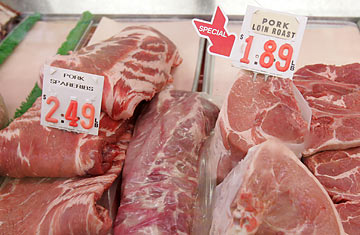
Various pork cuts for sale in Pacifica, Calif.
If you're in prison, now might be a good time to develop a taste for pork. The same is probably true if you're in the military or in a public school. As part of a government effort to boost America's hog farmers — who have identified themselves as the forgotten casualties of the H1N1 swine-flu epidemic and asked Washington for financial help — the Agriculture Department announced last week a $30 million purchase of surplus pork. That brings the federal total of pork purchases for fiscal 2009 to about $150 million, or close to $100 million more than last year's figure for the same period. During a Sept. 10 morning press conference, Secretary of Agriculture Tom Vilsack also said he would work with fellow Cabinet secretaries in the Defense, Justice and Education departments to encourage pork purchases on military bases, in prisons and in schools.
In addition, Vilsack took the opportunity to ask — indeed, plead — with the media to desist forever from use of the misnomer swine flu, which has been the cause of many of the pork industry's woes. "It may seem silly," said Vilsack, "unless you're a pork producer. Then, you have to tell your family you can't afford to pay the bills because you're now selling your product for less than it cost you to produce it."
It was soon after the first reports of the so-called swine flu emerged in the spring of 2009 that the already soft hog market practically collapsed. In China, a major consumer of U.S. pork, fully two-thirds of the 1.3 billion population stopped eating pork altogether, and Beijing responded with a ban on any pork produced in North Carolina, Iowa or Oklahoma. Russia and Ukraine followed with prohibitions of their own, and soon there were 27 countries that wanted nothing to do with any hog raised in America. Institutional buyers in the U.S. grew skittish too, as did big state and local consumers like school districts.
The U.S. government's most recent pork purchase comes just a few weeks after the National Pork Producers Council and a consortium of governors from nine pork-producing states sent separate letters to the Agriculture Secretary requesting assistance. The council asked the USDA to lift the $300 spending cap on pork products for government food programs, and to spend at least an additional $150 million on pork products during fiscal year 2009; the industry also asked for $100 million to help survey herds for H1N1. In a similar letter from state governors, lawmakers requested that the government urge overseas markets to start buying U.S. pork again, and Vilsack said he would lean on the international trading partners who haven't yet lifted their U.S. pork bans. "Among the ones who have been open to reason and logic," he says tartly, "many of the barriers are already down."
Of course, no H1N1 has been detected in any actual swine in the U.S., and even if it were, Vilsack stressed — his voice sometimes betraying a how-many-times-must-I-repeat-this weariness — people could not get sick by eating infected pork. H1N1 is not a hog-specific virus, Vilsack reminded reporters. "Swine flu has been present in the United States for 80 years," he said. "But H1N1 is different. It's a novel flu strain. Its genetic makeup is unique. The virus is connected to strains from three species — avian, human and swine. Unfortunately, the media gravitated toward the swine aspect of it. But that's unfair and it's not right."
The Agriculture Secretary does concede that the absence of the virus among American hogs so far does not mean that the herds will remain clean. He reported government scientists have thus developed a master seed strain of H1N1 that they are making available to five veterinary-drug makers that can prepare vaccines to be rolled out if and when any herds come down sick. "By making the seed virus, we estimate we've saved two to four months of development time. We hope the manufacturers will now make the vaccine," said Vilsack. The Agriculture Department is also stepping up surveillance efforts so that any infection in any U.S. herd will be quickly reported.
But beyond the government's fiscal assistance, Vilsack maintains that the media still hold the greatest sway over potential U.S. pork consumers. "People hear the President or some other official say once or twice that pork is safe," Vilsack said, "and then they hear the term swine flu on TV and the Internet 50 times in a single day." The blame-the-media fallback is surely overstated, but for pork farmers trying to move the merch, less swine and more H1N1 in headlines will nonetheless be welcome.
